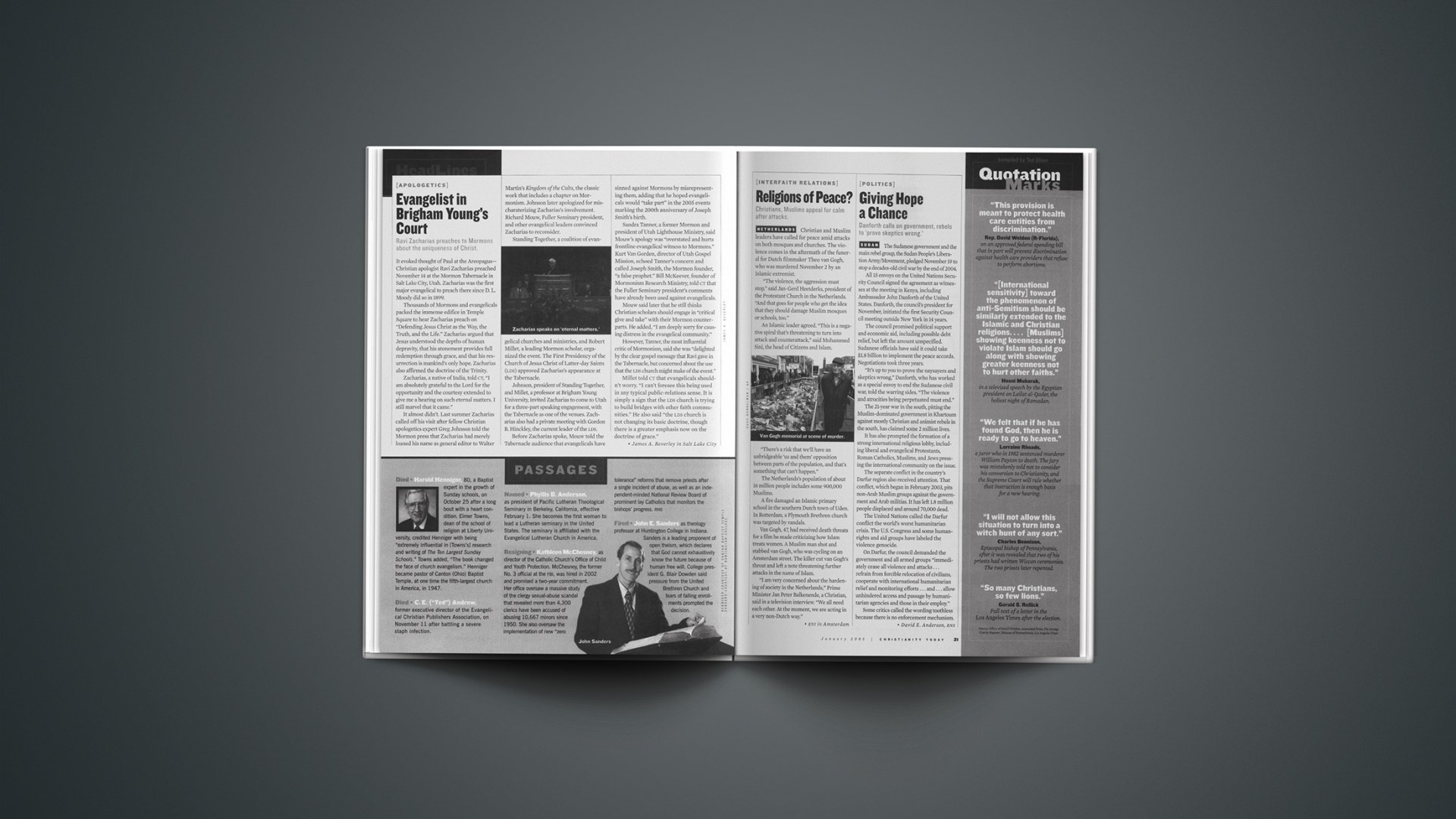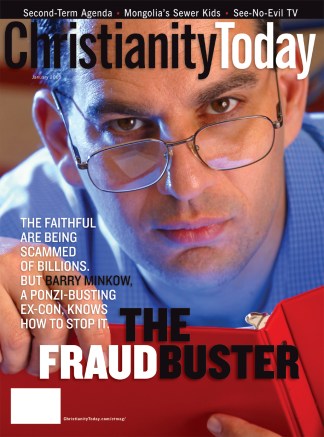It evoked thought of Paul at the Areopagus— Christian apologist Ravi Zacharias preached November 14 at the Mormon Tabernacle in Salt Lake City, Utah. Zacharias was the first major evangelical to preach there since D. L. Moody did so in 1899.
Thousands of Mormons and evangelicals packed the immense edifice in Temple Square to hear Zacharias preach on “Defending Jesus Christ as the Way, the Truth, and the Life.” Zacharias argued that Jesus understood the depths of human depravity, that his atonement provides full redemption through grace, and that his resurrection is mankind’s only hope. Zacharias also affirmed the doctrine of the Trinity.
Zacharias, a native of India, told CT, “I am absolutely grateful to the Lord for the opportunity and the courtesy extended to give me a hearing on such eternal matters. I still marvel that it came.”
It almost didn’t. Last summer Zacharias called off his visit after fellow Christian apologetics expert Greg Johnson told the Mormon press that Zacharias had merely loaned his name as general editor to Walter Martin’s Kingdom of the Cults, the classic work that includes a chapter on Mormonism. Johnson later apologized for mischaraterizing Zacharias’s involvement. Richard Mouw, Fuller Seminary president, and other evangelical leaders convinced Zacharias to reconsider.
Standing Together, a coalition of evangelical churches and ministries, and Robert Millet, a leading Mormon scholar, organized the event. The First Presidency of the Church of Jesus Christ of Latter-day Saints (LDS) approved Zacharias’s appearance at the Tabernacle.
Johnson, president of Standing Together, and Millet, a professor at Brigham Young University, invited Zacharias to come to Utah for a three-part speaking engagement, with the Tabernacle as one of the venues. Zacharias also had a private meeting with Gordon B. Hinckley, the current leader of the LDS.
Before Zacharias spoke, Mouw told the Tabernacle audience that evangelicals have sinned against Mormons by misrepresenting them, adding that he hoped evangelicals would “take part” in the 2005 events marking the 200th anniversary of Joseph Smith’s birth.
Sandra Tanner, a former Mormon and president of Utah Lighthouse Ministry, said Mouw’s apology was “overstated and hurts frontline evangelical witness to Mormons.” Kurt Van Gorden, director of Utah Gospel Mission, echoed Tanner’s concern and called Joseph Smith, the Mormon founder, “a false prophet.” Bill McKeever, founder of Mormonism Research Ministry, told CT that the Fuller Seminary president’s comments have already been used against evangelicals.
Mouw said later that he still thinks Christian scholars should engage in “critical give and take” with their Mormon counterparts. He added, “I am deeply sorry for causing distress in the evangelical community.”
However, Tanner, the most influential critic of Mormonism, said she was “delighted by the clear gospel message that Ravi gave in the Tabernacle, but concerned about the use that the LDS church might make of the event.”
Millet told CT that evangelicals shouldn’t worry. “I can’t foresee this being used in any typical public-relations sense. It is simply a sign that the LDS church is trying to build bridges with other faith communities.” He also said “the LDS church is not changing its basic doctrine, though there is a greater emphasis now on the doctrine of grace.”
Copyright © 2005 Christianity Today. Click for reprint information.
Related Elsewhere:
Weblog also commented on Ravi Zacharias’s trip to the Mormon Tabernacle.
Weblog: Ravi Zacharias, Rich Mouw Speak in Mormon Tabernacle | Indian-born apologist notes differences with LDS, Fuller head offers apology (Nov. 16, 2004)
Weblog: Ravi Zacharias to Speak at Mormon Tabernacle | Mormons open top pulpit to evangelical apologist (Sept. 17, 2004)
News elsewhere on the event includes:
Controversy surrounds Mormonism comments by Fuller exec. | Evangelical Christian leaders and experts on Mormonism have expressed dismay at recent comments made by Fuller Theological Seminary President Richard Mouw at the Church of Jesus Christ of Latter-day Saints’ “signature pulpit” in Salt Lake City. (Baptist Press, Nov 24, 2004)
‘We Have Sinned Against You’ | A leading evangelical speaks at the Mormon Tabernacle and says evangelicals have spread lies about LDS beliefs. (Beliefnet, no date)
Other Christianity Today articles about the Latter Day Saints includes:
LDS and DNA | Book challenges Native American link to ancient Israel. (Sept. 14, 2004)
Mormon Scholar Under Fire | Anthropologist says Latter-day Saints’ teaching wrong about Native Americans. (Feb. 19, 2003)
The Shiny, Happy Olympics | Coverage of Salt Lake City’s games focuses on who isn’t evangelizing. (Feb. 13, 2002)
Weblog: The Church of Jesus Christ? | Mormons: Don’t call us Mormons. (Feb. 20, 2001)
Mormon Makeover | An effective evangelical witness hinges on understanding the new face of Latter-day Saints. (March 6, 2000)
The Mormon-Evangelical Divide |Beliefs that set Mormons apart, and evangelicals’ response. (Feb. 9, 2000)
A Peacemaker in Provo | How one Pentecostal pastor taught his congregation to love Mormons. (Feb. 9, 2000)
Mere Mormonism | Journalist Richard Ostling explores LDS culture, theology, and fans of ‘crypto-Mormon’ C.S. Lewis. (Feb. 9, 2000)
Mormons, Evangelicals Tangle Over Web Site | A publishing unit of the Church of Jesus Christ of Latter-day Saints will continue a copyright lawsuit against an evangelical ministry that counters Mormon teaching and history. (Feb. 9, 2000)
Mormons on the Rise | Southern Baptists Take Up the Mormon Challenge. (June 15, 1998)
Evangelists Sue in Utah (November 11, 1996)
Francis J. Beckwith, coauthor of The Mormon Concept of God: A Philosophical Analysis, reviewed How Wide the Divide? for Christianity Today. The review, “With a Grain of Salt,” appeared in the November 17, 1997 of our print issue.
A review of Richard Ostlings’ book, Mormon America: The Power and the Promise, was published in Christianity Today sister publication Books & Culture. The review was written by two practicing Mormons.
Ostling’s cover story on Mormonism, “Kingdom Come,” from the August 4, 1997 of Time magazine, is available online.










